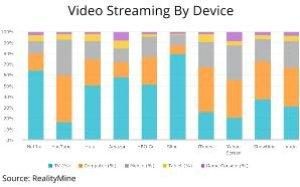Streaming of TV and video content continues to rise. While conventional TV sets continue to dominate the way consumers view it, digital devices — desktop/laptop computers, mobile devices, and tablets — each are growing their share. The findings of this research can be found in RealityMines recent press release:
- Streaming TV and video content is on the rise with the average person reporting spending 7.4 hours a week streaming TV, 5.0 hours a week accessing video from a computer, 3.1 hours a week accessing video from a mobile device, and 3.0 hours a week accessing video from a tablet.
- Of those streaming content, Netflix and YouTube have the highest daily reach (18% and 14% consecutively), as well as highest weekly reach (39% and 40% consecutively).
Despite TV being the leader of this distribution method, it isn’t something that digital publishers and online media professionals and the like should disregard.
According to Bree Brouwer, a contributor on EContent Mag “To put it simply, having even a basic knowledge of live streaming can benefit content publishers and creators. For example, internet marketer and Social Triggers founder Derek Halpern discovered his audience was more than eager to tune into an impromptu, live Periscope stream to learn marketing tips and lessons. In fact, Halpern garnered about 750 viewers on his first Periscope stream alone; that’s more attendees than some businesses can claim for their prescheduled webinars. Other examples such as having journalists streaming breaking news, or creative content publishers using it for live exclusive content can also benefit”.
Grass Media’s THE CHANGING DYNAMICS OF DIGITAL MEDIA PUBLISHING, LIVE STREAMING, AND SOCIAL INTERACTIVITY 2014 whitepaper also highlights the industry challenges of leveraging content streaming, saying “Meeting increasing consumer demand for social media interactivity, which requires news directors and producers alike to plan for and execute on ALL social media platforms. This is necessary to compete effectively as well as retain and grow audiences, but has to be implemented with existing resources and easy-to-use production tools”.












